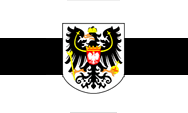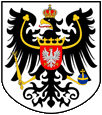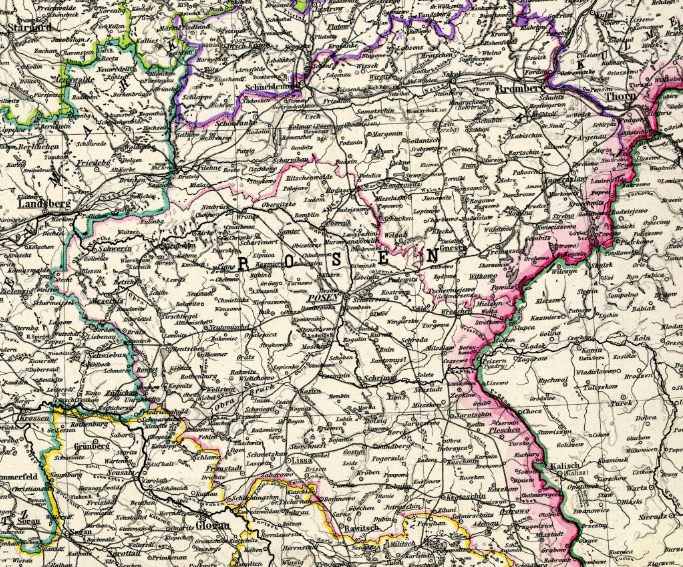mobile View, to the German Version tap the flag


- Posen (pl.: Poznań)
- to 1920 Prussian province
• Flags
• historical Flag
• Meaning/Origin of the Flag
• Coat of Arms
• Meaning/Origin of the Coat of Arms
• Map
• Numbers and Facts
• History
• Origin of the Country's Name

1886–1920,
Colours of the country,
ratio = 3:5




1886–1920,
official flag (doubtful),
ratio = 3:5





1815–1886,
Flag of the province




The flag of the Grand Duchy and even of the Province of Posen was initially a flag in the Polish colors red and white, because Posen was a Polish crown-land. In context with the germanization this flag was abolished to favor of a combination from the Prussian colors black and white. However the eagle showed in the breast shield still the crowned Polish eagle.
Source:
Volker Preuß


Coat of arms of Posen,
Source, by: Wikipedia (D)

The origins of the Prussian heraldry can be found in Royal Polish Prussia when these areas (Pomerelia [later West Prussia], Kulm Land, Marienburg and Elbing) were ceded to the Kingdom of Poland in 1466 and became a fief of the Polish king. A coat of arms was created for this country. It showed the Polish eagle in black on a silver (white) background with a sword arm. The colors were probably not chosen at random, after all, the Royal Polish Prussia was previously a territory of the Teutonic Order, the colors of the order were black and white (black cross on a white background). In 1525, Grand Master Albrecht converted the remaining State of the Teutonic Order (in principle the area of what would later become East Prussia, but without the Diocese of Warmia) into the secular Duchy of Prussia, Albrecht became the duke and swore the oath of fief to the Polish king. Another coat of arms was created for this, again according to the same principles. It showed the Polish eagle in black on a silver (white) background and it had a crowned breastplate with the initial "S" of the Polish king Sigismund. The coat of arms of Prussia was thus created. Later, when Prussia was divided into provinces, this original Prussian coat of arms became the coat of arms of the province of East Prussia, but without the breastplate with the "S", which had already become obsolete in 1557 when the Polish feudal sovereignty ceased to exist. On the occasion of the Polish divisions, Prussia was able to gain Royal Polish Prussia in 1772. Its coat of arms (the eagle with the sword arm) was adopted for the later province of West Prussia. This black eagle on white background appears in most of the coats of arms of the provinces of Prussia, but especially in the eastern parts of the country, where the roots of Prussia lie. The eagle in the coat of arms of Posen showed the crowned Polish eagle in the breast shield.
Source: Volker Preuß


Source:
Stielers Hand-Atlas, Justus Perthes, 1891
The historical map shows the province of Posen around the year 1890, in the north (in violet) the border with West Prussia, in the west (in green) the border with Brandenburg, in the south (in yellow) the border with Silesia, and in the east (in red) the outer border of the German Empire.

Area: 11.180 square miles (1885)
Inhabitants: 1.715.618 Ew., thereof 51% Polish, 42% Germans (1885)
Density of Population: 153 inh./sq.mi. (1885)
Capital: Posen (Poznań)
Source: Meyers Konversationslexikon

1st cent. · settlement by Germanic tribes (Goths)
3rd cent. · settlement by Slavs
about 1250 · German settlement
ca. 900 to 1793 · to the Polish state → "Wielkopolskie" ("Great Poland")
1793 · Second Polish Division, to Prussia
1807–1813 · to the Duchy of Warsaw
1813–1815 · Russian military administration
1815–1830 · Prussian Grand Duchy of Posen
1830 · Warsaw Rebellion
1830–1920 · Prussian Province of Posen
1920–1939 · to Poland
1939 · re-annexation of the Province of Posen to Prussia as "Imperial Gau of Wartheland" → expulsion of the Polish population
1945 · soviet conquest, annexation by Poland → expulsion of the German population
1999 · re-construction of the Voivodeship of "Wielkopolskie" in the borders of the Province of Posen
Source:
Atlas zur Geschichte,
Wikipedia (D),
Schwarzbuch der Vertreibung,
Discovery '97

The name of the province goes of course back to the name of the capital of the province, the city of Posen. In Polish it is called Poznań, which could be traced back to the word "Poznan", which means "the known", or traced back to the verb "poznać", which means "recognize" and can thus be interpreted as "known city".
Source:
Wikipedia (EN),
Volker Preuß







![]()











